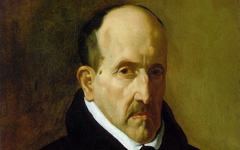Picasso’s Self-Portrait (late1901)

Picasso, Self-portrait (late 1901/early 1902) Black chalk with watercolor on paper. National Gallery of Art, Washington, DC
Click image to enlarge.
One theme common to poetic art in the West - and used on this site under Artist as Other Artist - is the artist's adoption of another's persona. It has been practised for centuries though the idea is sometimes more easily seen in modern art. Susan Grace Galassi was right on target when she wrote recently about this self-portrait drawing by Picasso that "throughout his early years, Picasso made use of allusions to works by other artists whose identities he 'tries on' and weaves into his own. In some works, such as this one, the identification is more explicit as Picasso models himself in the guise of a predecessor's self-portrait."1
Click next thumbnail to continue

Left: Detail of Picasso's Self-portrait
Right: Detail of Poussin's Self-portrait
Click image to enlarge.
She notes that Pierre Daix has also written: "Picasso does not redo Poussin. He is Poussin in 1901."2 The expression and pose in the self-portrait at left - as well as the tiny triangle of his white collar - link it to Poussin's self-portrait.3 So does the division of Picasso's face into dark and light halves. Picasso even adopts Poussin's centrally parted hair which I have no doubt Picasso did not actually brush that way in life.
Click next thumbnail to continue

Picasso, Self-portrait (late 1901/early 1902) Black chalk with watercolor on paper. National Gallery of Art, Washington, DC
Click image to enlarge.
"Picasso", Galassi continues,"portrays himself as if hovering, coming into being with the coalescence of marks on the sheet, with echoes of other artists' self-representations underlying his image."4
To make their oeuvre unerringly inventive while remaining true to the canon's overall purpose, artists cannot just adopt one technique - say, face fusion - to make their art self-reflective. Among other methods they use the faces, personas and styles of earlier artists with whom they feel at one to both disguise and convey their meaning. Picasso, having visited some Neolithic caves in France, wondered whether he might not have been the same little artist reincarnated time and again from the Stone Age to the Paris of his day.
More Works by Picasso
Notes:
1. Picasso's Drawings, 1890-1921 (New York: Frick Collection) 2011, p. 80
2. ibid, p. 82
3. Galassi credits Joanna Sheers with the observation that the tiny white triangle of collar links the two self-portraits. ibid., p. 83, n.6
4. ibid., p. 83
5. André Malraux, Picasso's Mask, trans. J. and J. Guicharnaud (New York: Holt, Rinehart and Winston) 1976, p. 143
Original Publication Date on EPPH: 28 Dec 2011. | Updated: 0. © Simon Abrahams. Articles on this site are the copyright of Simon Abrahams. To use copyrighted material in print or other media for purposes beyond 'fair use', you must obtain permission from the copyright owner. Websites may link to this page without permission (please do) but may not reproduce the material on their own site without crediting Simon Abrahams and EPPH.



